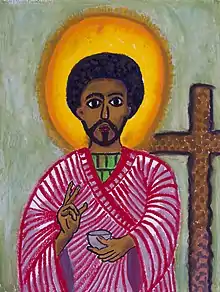Michael the Deacon
Michael the Deacon was a deacon in the Ethiopian Orthodox Church in the 16th century A.D.[1]
Michael the Deacon | |
|---|---|
 | |
| Personal | |
| Born | Michael the Deacon c. 1500s |
| Religion | Christianity |
| Denomination | Oriental Orthodox |
| Profession | Deacon |
| Church | Ethiopian Orthodox Tewahedo Church |
| Senior posting | |
| Profession | Deacon |
In 1534, Michael the Deacon travelled to Wittenberg and met with Martin Luther, a leader in the Reformation.[2][3] During the meeting, the two compared the Lutheran Mass with that used by the Ethiopian Orthodox Church and found that they were in agreement with one another.[1][4] Michael the Deacon also affirmed Luther's Articles of the Christian Faith as a "good creed".[3][1] As such, the Lutheran Churches extended full communion to the Ethiopian Orthodox Church.[5][1]
References
- Daniels, David D. (21 October 2017). "Honor the Reformation's African roots". The Commercial Appeal. Retrieved 9 April 2018.
- Luther Digest: An Annual Abridgment of Luther Studies, Volumes 2-4. Luther Academy. 1994. p. 146.
During the summer of 1534, an Ethiopian monk Deacon Michael visited Wittenberg. With great satisfaction Luther recorded that among the Christians in Ethiopia neither the private Mass nor the Mass canon was known, and their order of service generally corresponded to that of evangelical congregations of Germany (WA Tr 5:450, #6045).
- Daniels, David D. (2 November 2017). "Martin Luther and Ethiopian Christianity: Historical Traces". University of Chicago. Retrieved 9 April 2018.
- Daniels, David D. (28 October 2017). "Martin Luther's 'dream' church? It wasn't in Europe". Religion News Service. Retrieved 9 April 2018.
- Daniels, David D. (31 October 2017). "Martin Luther's fascination with Ethiopian Christianity". The Christian Century. Retrieved 9 April 2018.
Luther extended full fellowship to Deacon Michael and the Ethiopian Church, an invitation Luther withheld from the Bohemian Brethren (the Hussites) and Reformed Churches connected to Ulrich Zwingli.
This article is issued from Wikipedia. The text is licensed under Creative Commons - Attribution - Sharealike. Additional terms may apply for the media files.